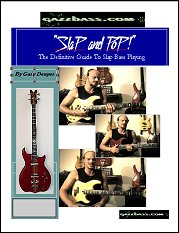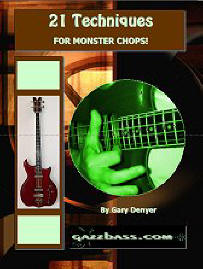
|
 |
|

Guitar Center Now Ships
Internationally
to over 90 countries! |
|
 |
|
 |
|
 |
|
|
 |

|
Bassline Breakdown
CORONET, WOOLWICH SOLO BY MARK KING PART 1
|
|
In 1983, Level 42 bass maestro Mark King would pen a slap solo piece that would be synonymous with his name for the rest of his career. This piece was first made available to the mass populous on the "Live - A Physical Presence" album, where it featured just before the start of the song "Love Games", played live in Coronet, Woolwich, March 1985. The solo has been played live by Mark time and time again, each time giving us a different variation of the piece.
The "Live - A Physical Presence" starts with Marks' already famous "Dune Tune", the subject for another Breakdown! perhaps. The piece we're interested in for this edition is the slap piece of the solo.
(Note: It is advisable that you read my lesson on Slap Triplets before you continue. This Breakdown! also assumes that the player has a solid slap foundation. If you wish to learn slap bass in detail, allow me to plug my DVD "SlaP and PoP!").
We will keep a reasonably slow pace throughout the dissection, then we'll pump it up to full speed on re-assembly!
First Part - 1st Bar
Although this piece was written on a JayDee Supernatural Classic Series I, it can be played effectively on almost any instrument. We start by hitting an open - D, then playing the following pattern:
Loading the player ...
9th - 11th Fret on D-string hammer-on, 9th Fret G-string pop
7th Fret D-String slap, followed by 7th - 9th Fret on D-string hammer-on, 7th Fret G-string pop
Two muted note slaps on E-string, one open E slap, one hammer-on mute with fret hand (using index, middle and fore finger), one muted note slap on E-string, and one dead string pop on G... (all these notes are 16th notes)
Second Part - 2nd Bar
The second part here follows closely on from the first, so its necessary to repeat a couple of notes from the first phrase to get the flow of the solo... namely the one muted note slap on E-string, and one dead string pop on G. The we continue into the second bar thus:
Loading the player ...
4th - 5th Fret A-String hammer-on, one muted note slap on E-string, one dead string pop on G and one open E slap.
(Note: this following technique is a bounce technique producing three notes in quick succession on the E-String)
Two muted note slaps on E-string followed by one open E slap, one hammer-on mute with fret hand and a 7th Fret G-string pop
Two muted note slaps on E-string followed by one open E slap, one hammer-on mute with fret hand and a 9th Fret G-string pop
Third Part - Join First Part and Second Part Together
What we do now is to play parts 1 and 2 together to start to get a feel for the solo and how is plays out.
Loading the player ...
It is important to concentrate on the muted and dead string parts of this solo, as this adds greatly to the speed effect of the piece. If these techniques are executed correctly, they will give the impression that you are playing very fast, when in fact its all about economy of movement and correct execution of each note.
To the left you will see the full tab and video clip for the first two bars of the solo.
Fourth Part - 3rd And 4th Bars
The third bar of the solo is exactly the same as the first bar, except that no open D is played at the start of the phrase.
The fourth bar gives the solo its first end-point, whereupon the player can loop back and play the first phrase again, giving the piece a certain cyclic feel to it. The fourth bar is similar to the second, so if you've practices the second bar, this should be familiar. Its necessary to repeat a couple of notes from the first phrase to get the flow of the solo... namely the one muted note slap on E-string, and one dead string pop on G. The we continue into the fourth bar thus:
Loading the player ...
4th - 5th Fret A-String hammer on, one muted note slap on E-string, one dead string pop on G, one muted note slap on E-string, one open E slap, 6th Fret G-string pop... then play a 2-note G-maj 9th chord (3rd Fret on E-string and 4th Fret on G-string, played together).
Fifth Part - Join Third Part and Fourth Part Together
What we do now is to play the third and fourth bars together.
Loading the player ...
Once again, it is important to concentrate on the muted and dead string parts of this solo, as this adds greatly to the speed effect of the piece.
To the left you will see the full tab and video clip for the first two bars of the solo.
Now... Join The Whole Lot Together!
Now that the major pieces of the solo have been covered in tab, notation and video format, its time to play a few bars of whole first phrase of the solo all strung together!
Play the piece slow to start with and then build up speed. Remember, this piece should not be played too fast to begin with, otherwise its likely that you'll lose the rhythm of the solo.
Loading the player ...
I hope you enjoyed this edition "Breakdown!" article! I'll be back soon with the next phrase of the "CORONET, WOOLWICH SOLO"!
Coming Up In The Next Edition...
In the next edition of Breakdown!, we'll look at the rest of this ground-breaking solo, then we'll join PART 1 and PART 2 of this series to get the whole solo! See you next time!
|
|
|
Download
Breakdown Package!
|
|
Go Back
To Breakdown! Home |
|
|
|
|
 |
|
|
Slap And Pop! DVD
|

|
|
By
Gary Denyer
|
| |
|
This comprehensive GAZZBASS.COM DVD SET, "SlaP And PoP" chronicles the bass guitar, its history, and the techniques of slap bass playing. A must for the beginner or intermediate, and a great reference work for the advanced, "SlaP And PoP" is both a musical journey and a teaching tool for all the budding slappers out there...
|
|
Learn
More...
|
|
|
|
21 Techniques For Monster Chops
|

|
|
By
Gary Denyer
|
| |
|
"21 Techniques For Monster Chops!" is a vastly revised and immeasurably more informative version of our online slap bass mini course! Due to an enormous amount of requests and questions, we've produced this all-inclusive DVD! With 7 extra techniques and a book full of tab, notation and explanations...
|
|
Learn
More...
|
|
|
|
| |
|